A Probabilistic Approach to Mapping the Contribution of Individual Riverine Discharges into Liverpool Bay Using Distance Accumulation Cost Methods on Satellite Derived Ocean-Colour Data
Abstract
1. Introduction
2. Materials and Methods
2.1. Study Area
2.2. DIN Discharge Loads from Rivers into Liverpool Bay
2.3. Earth Observation Data Processing and Generation of the River Plume Boundary
2.4. Current Direction in Liverpool Bay
2.5. Generation of Monthly DIN Exposure Risk Maps for the Liverpool Bay River Plume
2.5.1. Spatial Plume Frequency Maps
2.5.2. Spatial Probability of Riverine Input across the River Plume
2.5.3. Spatial Normalised Potential of DIN in the River Plume
2.5.4. Calculation of Risk of DIN Exposure in the River Plume from Individual Rivers
2.5.5. Calculation of Risk of DIN Exposure in the River Plume from All River Inputs
3. Results
3.1. Boundary Extent and Seasonal Frequency of the Primary River Plume
3.2. Spatial Probability of Riverine Input into the Plume
3.3. Normalised Distance Accumulation Grids of DIN from the Major Rivers
3.4. DIN Exposure Risk Maps for Riverine Inputs into Liverpool Bay
3.5. Scaling Probabilistic Risk Maps to Reflect the Differing Riverine DIN Discharge Loads
3.6. Annual Exposure Risk to DIN in Liverpool Bay
4. Discussion
5. Conclusions
Supplementary Materials
Author Contributions
Funding
Data Availability Statement
Acknowledgments
Conflicts of Interest
References
- Paerl, H.W. Assessing and Managing Nutrient-Enhanced Eutrophication in Estuarine and Coastal Waters: Interactive Effects of Human and Climatic Perturbations. Ecol. Eng. 2006, 26, 40–54. [Google Scholar] [CrossRef]
- Billen, G.; Garnier, J.; Némery, J.; Sebilo, M.; Sferratore, A.; Barles, S.; Benoit, P.; Benoît, M. A Long-Term View of Nutrient Transfers through the Seine River Continuum. Sci. Total Environ. 2007, 375, 80–97. [Google Scholar] [CrossRef] [PubMed]
- Bricker, S.B.; Longstaff, B.; Dennison, W.; Jones, A.; Boicourt, K.; Wicks, C.; Woerner, J. Effects of Nutrient Enrichment in the Nation’s Estuaries: A Decade of Change. Harmful Algae 2008, 8, 21–32. [Google Scholar] [CrossRef]
- Paerl, H.W. Controlling Eutrophication along the Freshwater–Marine Continuum: Dual Nutrient (N and P) Reductions Are Essential. Estuaries Coasts 2009, 32, 593–601. [Google Scholar] [CrossRef]
- Wurtsbaugh, W.A.; Paerl, H.W.; Dodds, W.K. Nutrients, Eutrophication and Harmful Algal Blooms along the Freshwater to Marine Continuum. WIREs Water 2019, 6, e1373. [Google Scholar] [CrossRef]
- Hantoro, I.; Löhr, A.J.; Van Belleghem, F.G.A.J.; Widianarko, B.; Ragas, A.M.J. Microplastics in Coastal Areas and Seafood: Implications for Food Safety. Food Addit. Contam. Part A 2019, 36, 674–711. [Google Scholar] [CrossRef]
- Zhang, M.; Sun, X.; Xu, J. Heavy Metal Pollution in the East China Sea: A Review. Mar. Pollut. Bull. 2020, 159, 111473. [Google Scholar] [CrossRef]
- Macdonald, A.M.; Edwards, A.C.; Pugh, K.B.; Balls, P.W. Soluble Nitrogen and Phosphorus in the River Ythan System, U.K.: Annual and Seasonal Trends. Water Res. 1995, 29, 837–846. [Google Scholar] [CrossRef]
- Bowes, M.J.; Smith, J.T.; Neal, C.; Leach, D.V.; Scarlett, P.M.; Wickham, H.D.; Harman, S.A.; Armstrong, L.K.; Davy-Bowker, J.; Haft, M.; et al. Changes in Water Quality of the River Frome (UK) from 1965 to 2009: Is Phosphorus Mitigation Finally Working? Sci. Total Environ. 2011, 409, 3418–3430. [Google Scholar] [CrossRef] [PubMed]
- Bowes, M.J.; Palmer-Felgate, E.J.; Jarvie, H.P.; Loewenthal, M.; Wickham, H.D.; Harman, S.A.; Carr, E. High-Frequency Phosphorus Monitoring of the River Kennet, UK: Are Ecological Problems Due to Intermittent Sewage Treatment Works Failures? J. Environ. Monit. 2012, 14, 3137. [Google Scholar] [CrossRef]
- Vane, C.H.; Kim, A.W.; Lopes Dos Santos, R.A.; Moss-Hayes, V. Contrasting Sewage, Emerging and Persistent Organic Pollutants in Sediment Cores from the River Thames Estuary, London, England, UK. Mar. Pollut. Bull. 2022, 175, 113340. [Google Scholar] [CrossRef] [PubMed]
- Johnstone, D.; Horan, N. Institutional Developments, Standards and River Quality: A UK History and Some Lessons for Industrialising Countries. Water Sci. Technol. 1996, 33, 211–222. [Google Scholar] [CrossRef]
- Skinner, J.A.; Lewis, K.A.; Bardon, K.S.; Tucker, P.; Catt, J.A.; Chambers, B.J. An Overview of the Environmental Impact of Agriculture in the U.K. J. Environ. Manag. 1997, 50, 111–128. [Google Scholar] [CrossRef]
- Withers, P.J.A.; Lord, E.I. Agricultural Nutrient Inputs to Rivers and Groundwaters in the UK: Policy, Environmental Management and Research Needs. Sci. Total Environ. 2002, 282–283, 9–24. [Google Scholar] [CrossRef]
- Moss, B. Water Pollution by Agriculture. Philos. Trans. Biol. Sci. 2008, 363, 659–666. [Google Scholar] [CrossRef] [PubMed]
- Burgan, H.I.; Icaga, Y.; Bostanoglu, Y.; Kilit, M. Water Quality Tendency of Akarçay River between 2006–2011. Pamukkale J. Eng. Sci. 2013, 19, 127–132. [Google Scholar] [CrossRef]
- Collins, A.L.; McGonigle, D.F. Monitoring and Modelling Diffuse Pollution from Agriculture for Policy Support: UK and European Experience. Environ. Sci. Policy 2008, 11, 97–101. [Google Scholar] [CrossRef]
- Devlin, M.; Brodie, J. Nutrients and Eutrophication. In Marine Pollution—Monitoring, Management and Mitigation; Reichelt-Brushett, A., Ed.; Springer Textbooks in Earth Sciences, Geography and Environment; Springer Nature: Cham, Switzerland, 2023; pp. 75–100. ISBN 978-3-031-10126-7. [Google Scholar]
- Withers, P.; Neal, C.; Jarvie, H.; Doody, D. Agriculture and Eutrophication: Where Do We Go from Here? Sustainability 2014, 6, 5853–5875. [Google Scholar] [CrossRef]
- Ulén, B.; Bechmann, M.; Fölster, J.; Jarvie, H.P.; Tunney, H. Agriculture as a Phosphorus Source for Eutrophication in the North-West European Countries, Norway, Sweden, United Kingdom and Ireland: A Review. Soil Use Manag. 2007, 23, 5–15. [Google Scholar] [CrossRef]
- Jarvie, H.P.; Neal, C.; Withers, P.J.A. Sewage-Effluent Phosphorus: A Greater Risk to River Eutrophication than Agricultural Phosphorus? Sci. Total Environ. 2006, 360, 246–253. [Google Scholar] [CrossRef]
- Neal, C.; Jarvie, H.P.; Withers, P.J.A.; Whitton, B.A.; Neal, M. The Strategic Significance of Wastewater Sources to Pollutant Phosphorus Levels in English Rivers and to Environmental Management for Rural, Agricultural and Urban Catchments. Sci. Total Environ. 2010, 408, 1485–1500. [Google Scholar] [CrossRef] [PubMed]
- Dagg, M.; Benner, R.; Lohrenz, S.; Lawrence, D. Transformation of Dissolved and Particulate Materials on Continental Shelves Influenced by Large Rivers: Plume Processes. Cont. Shelf Res. 2004, 24, 833–858. [Google Scholar] [CrossRef]
- Horner-Devine, A.R.; Hetland, R.D.; MacDonald, D.G. Mixing and Transport in Coastal River Plumes. Annu. Rev. Fluid Mech. 2015, 47, 569–594. [Google Scholar] [CrossRef]
- Devlin, M.; Petus, C.; Da Silva, E.; Tracey, D.; Wolff, N.; Waterhouse, J.; Brodie, J. Water Quality and River Plume Monitoring in the Great Barrier Reef: An Overview of Methods Based on Ocean Colour Satellite Data. Remote Sens. 2015, 7, 12909–12941. [Google Scholar] [CrossRef]
- Osadchiev, A.; Zavialov, P. Structure and Dynamics of Plumes Generated by Small Rivers. In Estuaries and Coastal Zones—Dynamics and Response to Environmental Changes; Pan, J., Devlin, A., Eds.; IntechOpen: London, UK, 2020; ISBN 978-1-78985-579-1. [Google Scholar]
- Fournier, S.; Lee, T. Seasonal and Interannual Variability of Sea Surface Salinity Near Major River Mouths of the World Ocean Inferred from Gridded Satellite and In-Situ Salinity Products. Remote Sens. 2021, 13, 728. [Google Scholar] [CrossRef]
- Environment Agency. River Basin Planning: Progress Report. Available online: https://www.gov.uk/government/publications/river-basin-planning-progress-report/river-basin-planning-progress-report (accessed on 25 May 2023).
- Fronkova, L.; Greenwood, N.; Martinez, R.; Graham, J.A.; Harrod, R.; Graves, C.A.; Devlin, M.J.; Petus, C. Can Forel–Ule Index Act as a Proxy of Water Quality in Temperate Waters? Application of Plume Mapping in Liverpool Bay, UK. Remote Sens. 2022, 14, 2375. [Google Scholar] [CrossRef]
- Álvarez-Romero, J.G.; Devlin, M.; Teixeira Da Silva, E.; Petus, C.; Ban, N.C.; Pressey, R.L.; Kool, J.; Roberts, J.J.; Cerdeira-Estrada, S.; Wenger, A.S.; et al. A Novel Approach to Model Exposure of Coastal-Marine Ecosystems to Riverine Flood Plumes Based on Remote Sensing Techniques. J. Environ. Manag. 2013, 119, 194–207. [Google Scholar] [CrossRef]
- Greenwood, N.; Devlin, M.J.; Best, M.; Fronkova, L.; Graves, C.A.; Milligan, A.; Barry, J.; Van Leeuwen, S.M. Utilizing Eutrophication Assessment Directives From Transitional to Marine Systems in the Thames Estuary and Liverpool Bay, UK. Front. Mar. Sci. 2019, 6, 116. [Google Scholar] [CrossRef]
- Polton, J.A.; Palmer, M.R.; Howarth, M.J. Physical and Dynamical Oceanography of Liverpool Bay. Ocean. Dyn. 2011, 61, 1421–1439. [Google Scholar] [CrossRef]
- Sánchez-Arcilla, A.; Wolf, J.; Monbaliu, J. Oceanography at Coastal Scales: Introduction to the Special Issue on Results from the EU FP7 FIELD_AC Project. Cont. Shelf Res. 2014, 87, 1–6. [Google Scholar] [CrossRef]
- Littlewood, I. Estimating Contaminant Loads in Rivers: A Review; IH Report, Report number 117; Institute of Hydrology: Wallingford, UK, 1992. [Google Scholar]
- Garaba, S.; Friedrichs, A.; Voß, D.; Zielinski, O. Classifying Natural Waters with the Forel-Ule Colour Index System: Results, Applications, Correlations and Crowdsourcing. Int. J. Environ. Res. Public Health 2015, 12, 16096–16109. [Google Scholar] [CrossRef]
- Van Der Woerd, H.J.; Wernand, M. True Colour Classification of Natural Waters with Medium-Spectral Resolution Satellites: SeaWiFS, MODIS, MERIS and OLCI. Sensors 2015, 15, 25663–25680. [Google Scholar] [CrossRef]
- Pitarch, J.; Van Der Woerd, H.J.; Brewin, R.J.W.; Zielinski, O. Optical Properties of Forel-Ule Water Types Deduced from 15 Years of Global Satellite Ocean Color Observations. Remote Sens. Environ. 2019, 231, 111249. [Google Scholar] [CrossRef]
- Stockman, A. CIE Physiologically Based Color Matching Functions and Chromaticity Diagrams. In Encyclopedia of Color Science and Technology; Luo, M.R., Ed.; Springer: New York, NY, USA, 2016; pp. 165–173. ISBN 978-1-4419-8070-0. [Google Scholar]
- Van Der Woerd, H.; Wernand, M. Hue-Angle Product for Low to Medium Spatial Resolution Optical Satellite Sensors. Remote Sens. 2018, 10, 180. [Google Scholar] [CrossRef]
- Petus, C.; Waterhouse, J.; Lewis, S.; Vacher, M.; Tracey, D.; Devlin, M. A Flood of Information: Using Sentinel-3 Water Colour Products to Assure Continuity in the Monitoring of Water Quality Trends in the Great Barrier Reef (Australia). J. Environ. Manag. 2019, 248, 109255. [Google Scholar] [CrossRef] [PubMed]
- Verspecht, F.; Rippeth, T.P.; Simpson, J.H.; Souza, A.J.; Burchard, H.; Howarth, M.J. Residual Circulation and Stratification in the Liverpool Bay Region of Freshwater Influence. Ocean. Dyn. 2009, 59, 765–779. [Google Scholar] [CrossRef]
- R Core Team. R: A Language and Environment for Statistical Computing. R Foundation for Statistical Computing, Vienna, Austria. 2021. Available online: https://www.R-Project.Org/ (accessed on 1 March 2023).
- Hijmans, R.J. Raster: Geographic Data Analysis and Modeling. 2021. Available online: https://CRAN.R-project.org/package=raster (accessed on 1 March 2023).
- Bivand, R.; Keitt, T.; Rowlingson, B. Rgdal: Bindings for the “Geospatial” Data Abstraction Library. 2021. Available online: https://CRAN.R-project.org/package=rgdal (accessed on 1 March 2023).
- Sievert, C. Interactive Web-Based Data Visualization with R, Plotly, and Shiny; Chapman and Hall/CRC: Boca Raton, FL, USA, 2020; ISBN 978-1-138-33145-7. [Google Scholar]
- Verspecht, F.; Rippeth, T.P.; Howarth, M.J.; Souza, A.J.; Simpson, J.H.; Burchard, H. Processes Impacting on Stratification in a Region of Freshwater Influence: Application to Liverpool Bay. J. Geophys. Res. 2009, 114, C11022. [Google Scholar] [CrossRef]
- Howarth, M.J.; Balfour, C.A.; Player, R.J.J.; Polton, J.A. Assessment of Coastal Density Gradients near a Macro-Tidal Estuary: Application to the Mersey and Liverpool Bay. Cont. Shelf Res. 2014, 87, 73–83. [Google Scholar] [CrossRef]
- Sharples, J.; Middelburg, J.J.; Fennel, K.; Jickells, T.D. What Proportion of Riverine Nutrients Reaches the Open Ocean? Riverine Nutrients Reaching the Ocean. Glob. Biogeochem. Cycles 2017, 31, 39–58. [Google Scholar] [CrossRef]
- Allan, I.; Vrana, B.; Greenwood, R.; Mills, G.; Roig, B.; Gonzalez, C. A “Toolbox” for Biological and Chemical Monitoring Requirements for the European Union’s Water Framework Directive. Talanta 2006, 69, 302–322. [Google Scholar] [CrossRef] [PubMed]
- Bean, T.P.; Greenwood, N.; Beckett, R.; Biermann, L.; Bignell, J.P.; Brant, J.L.; Copp, G.H.; Devlin, M.J.; Dye, S.; Feist, S.W.; et al. A Review of the Tools Used for Marine Monitoring in the UK: Combining Historic and Contemporary Methods with Modeling and Socioeconomics to Fulfill Legislative Needs and Scientific Ambitions. Front. Mar. Sci. 2017, 4, 263. [Google Scholar] [CrossRef]
- Wu, M.-L.; Wang, Y.-S.; Sun, C.-C.; Wang, H.; Dong, J.-D.; Yin, J.-P.; Han, S.-H. Identification of Coastal Water Quality by Statistical Analysis Methods in Daya Bay, South China Sea. Mar. Pollut. Bull. 2010, 60, 852–860. [Google Scholar] [CrossRef] [PubMed]
- Statham, P.J. Nutrients in Estuaries—An Overview and the Potential Impacts of Climate Change. Sci. Total Environ. 2012, 434, 213–227. [Google Scholar] [CrossRef]
- Tong, X.; Mohapatra, S.; Zhang, J.; Tran, N.H.; You, L.; He, Y.; Gin, K.Y.-H. Source, Fate, Transport and Modelling of Selected Emerging Contaminants in the Aquatic Environment: Current Status and Future Perspectives. Water Res. 2022, 217, 118418. [Google Scholar] [CrossRef] [PubMed]
- Uzun, P.; Farazande, S.; Guven, B. Mathematical Modeling of Microplastic Abundance, Distribution, and Transport in Water Environments: A Review. Chemosphere 2022, 288, 132517. [Google Scholar] [CrossRef] [PubMed]
- Xing, J.; Chen, S. A Process Study of the Interaction of Tidal Currents, Tidal Mixing and Density Gradients in a Region of Freshwater Influence. J. Mar. Syst. 2017, 172, 51–63. [Google Scholar] [CrossRef]
- Falconer, R.; Lin, B.; Harpin, R. Environmental Modelling in River Basin Management. Int. J. River Basin Manag. 2005, 3, 169–184. [Google Scholar] [CrossRef]
- Álvarez-Romero, J.G.; Pressey, R.L.; Ban, N.C.; Brodie, J. Advancing Land-Sea Conservation Planning: Integrating Modelling of Catchments, Land-Use Change, and River Plumes to Prioritise Catchment Management and Protection. PLoS ONE 2015, 10, e0145574. [Google Scholar] [CrossRef]
- O’Neill, C.K.; Polton, J.A.; Holt, J.T.; O’Dea, E.J. Modelling Temperature and Salinity in Liverpool Bay and the Irish Sea: Sensitivity to Model Type and Surface Forcing. Ocean Sci. 2012, 8, 903–913. [Google Scholar] [CrossRef]
- Wolff, N.H.; Da Silva, E.T.; Devlin, M.; Anthony, K.R.N.; Lewis, S.; Tonin, H.; Brinkman, R.; Mumby, P.J. Contribution of Individual Rivers to Great Barrier Reef Nitrogen Exposure with Implications for Management Prioritization. Mar. Pollut. Bull. 2018, 133, 30–43. [Google Scholar] [CrossRef]
- Jafar-Sidik, M.; Bowers, D.G.; Griffiths, J.W. Remote Sensing Observations of Ocean Colour Using the Traditional Forel-Ule Scale. Estuar. Coast. Shelf Sci. 2018, 215, 52–58. [Google Scholar] [CrossRef]
- Groom, S.; Sathyendranath, S.; Ban, Y.; Bernard, S.; Brewin, R.; Brotas, V.; Brockmann, C.; Chauhan, P.; Choi, J.; Chuprin, A.; et al. Satellite Ocean Colour: Current Status and Future Perspective. Front. Mar. Sci. 2019, 6, 485. [Google Scholar] [CrossRef]
- Guillou, N.; Rivier, A.; Gohin, F.; Chapalain, G. Modeling Near-Surface Suspended Sediment Concentration in the English Channel. JMSE 2015, 3, 193–215. [Google Scholar] [CrossRef]
- Fournier, S.; Chapron, B.; Salisbury, J.; Vandemark, D.; Reul, N. Comparison of Spaceborne Measurements of Sea Surface Salinity and Colored Detrital Matter in the Amazon Plume: SSS-Cdm Comparison in the Amazon Plume. J. Geophys. Res. Ocean. 2015, 120, 3177–3192. [Google Scholar] [CrossRef]
- Schroeder, T.; Devlin, M.J.; Brando, V.E.; Dekker, A.G.; Brodie, J.E.; Clementson, L.A.; McKinna, L. Inter-Annual Variability of Wet Season Freshwater Plume Extent into the Great Barrier Reef Lagoon Based on Satellite Coastal Ocean Colour Observations. Mar. Pollut. Bull. 2012, 65, 210–223. [Google Scholar] [CrossRef] [PubMed]
- Beher, J.; Possingham, H.P.; Hoobin, S.; Dougall, C.; Klein, C. Prioritising Catchment Management Projects to Improve Marine Water Quality. Environ. Sci. Policy 2016, 59, 35–43. [Google Scholar] [CrossRef]
- Devlin, M.J.; McKinna, L.W.; Álvarez-Romero, J.G.; Petus, C.; Abott, B.; Harkness, P.; Brodie, J. Mapping the Pollutants in Surface Riverine Flood Plume Waters in the Great Barrier Reef, Australia. Mar. Pollut. Bull. 2012, 65, 224–235. [Google Scholar] [CrossRef] [PubMed]
- Arnold, J.G.; Kiniry, J.R.; Srinivasan, R.; Williams, J.R.; Haney, E.B.; Neitsch, S.L. Soil and Water Assessment Tool Input/Output File Documentation Version 2009; Texas Water Resources Institute: College Station, TX, USA, 2011. [Google Scholar]
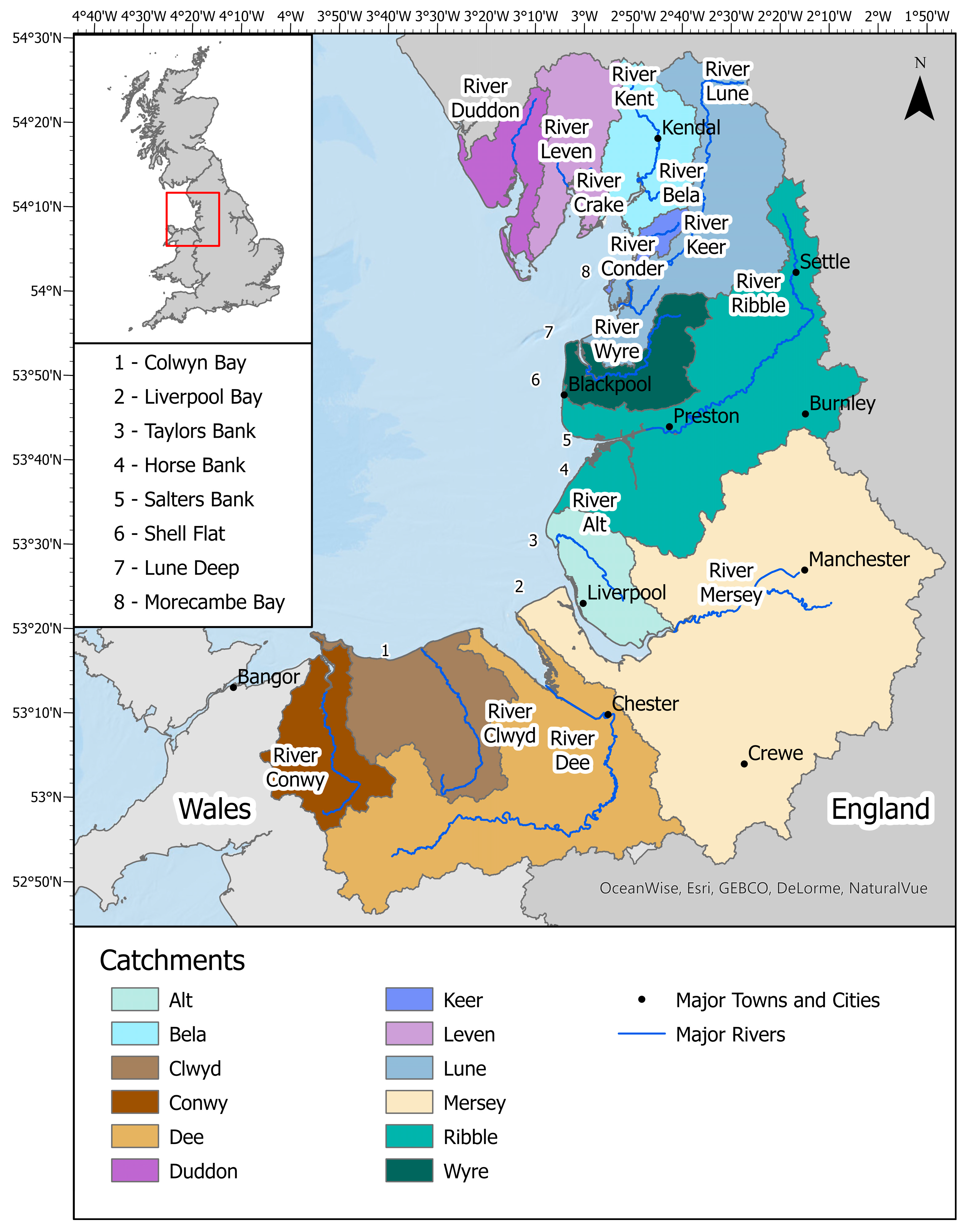
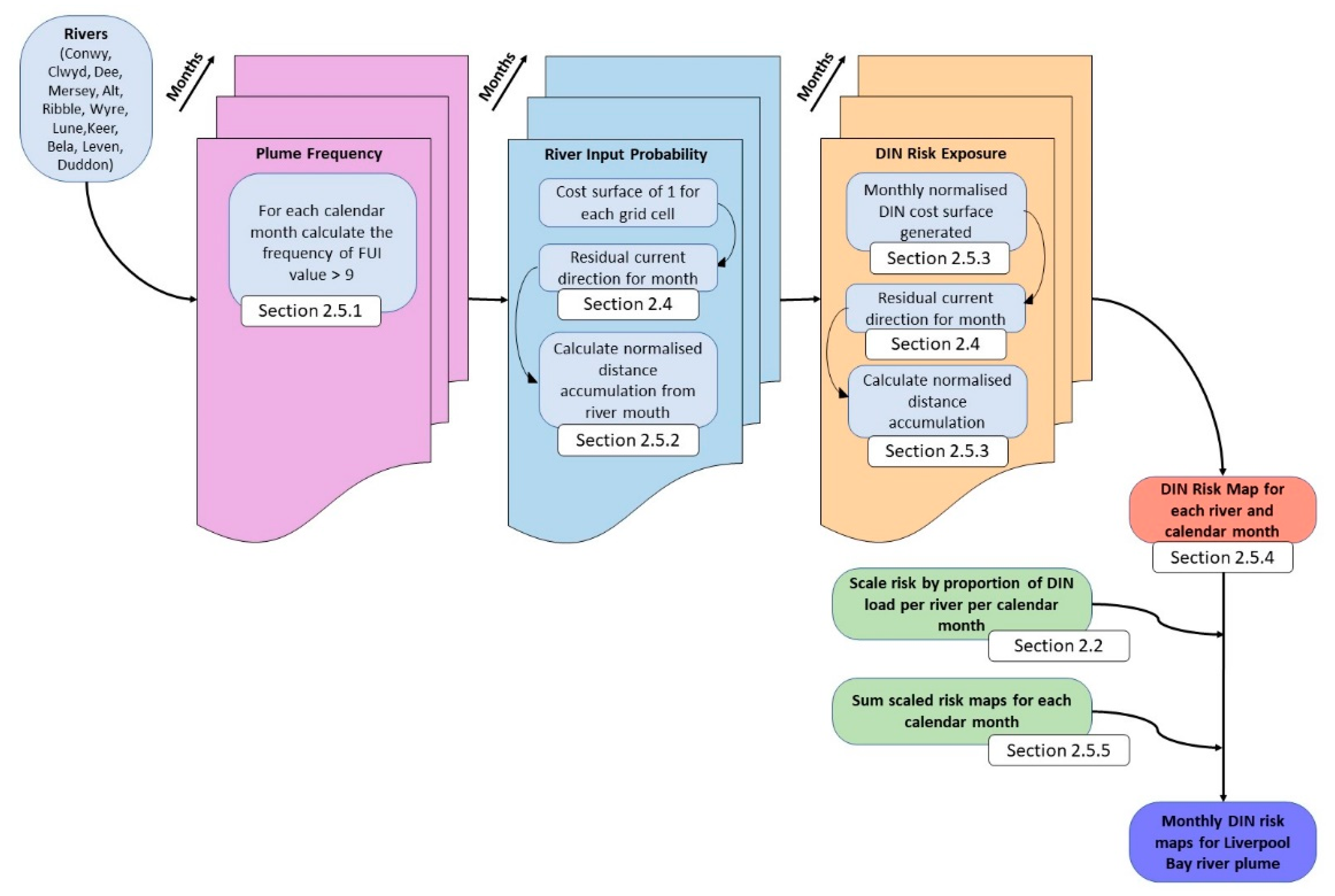
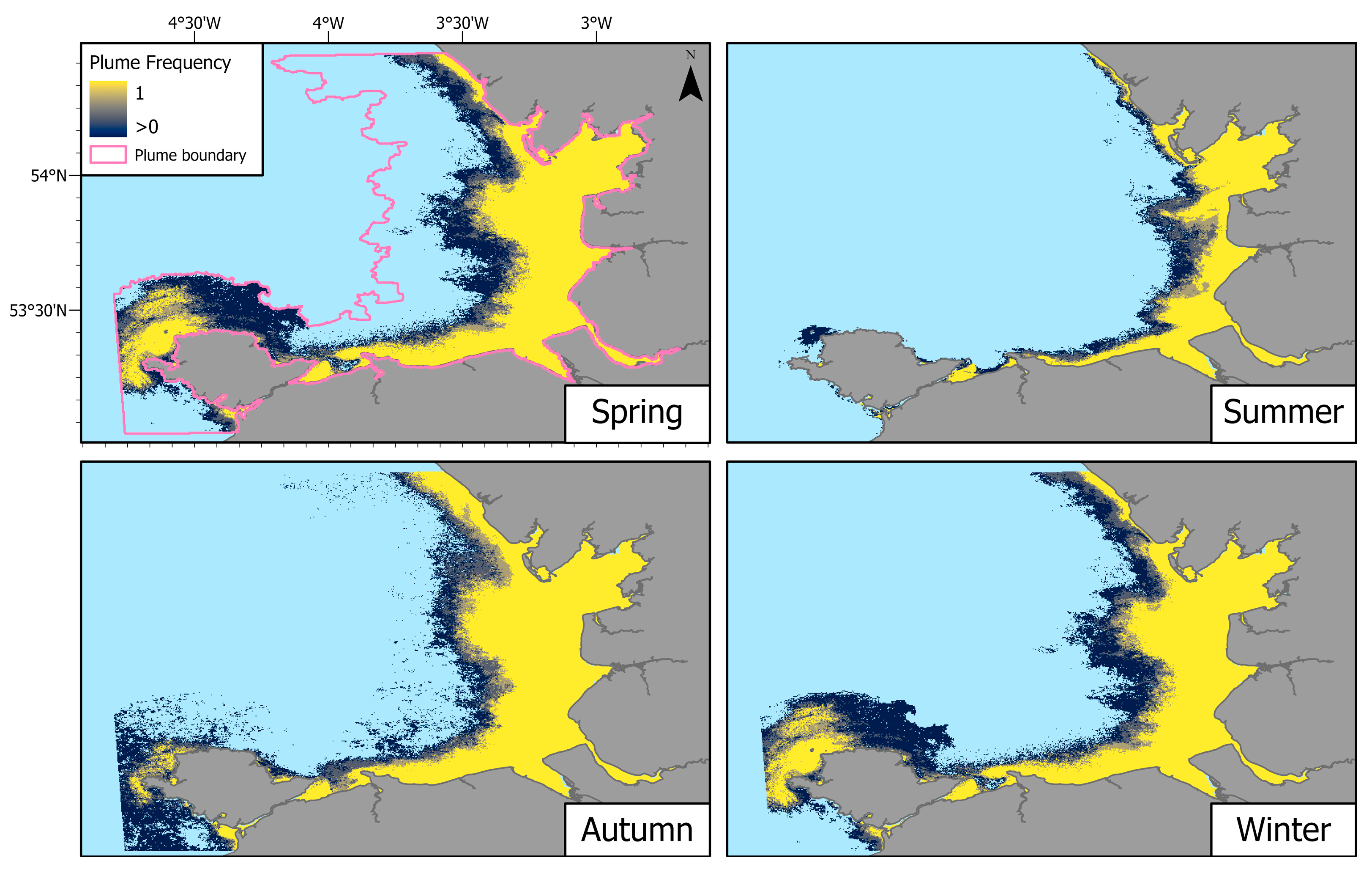
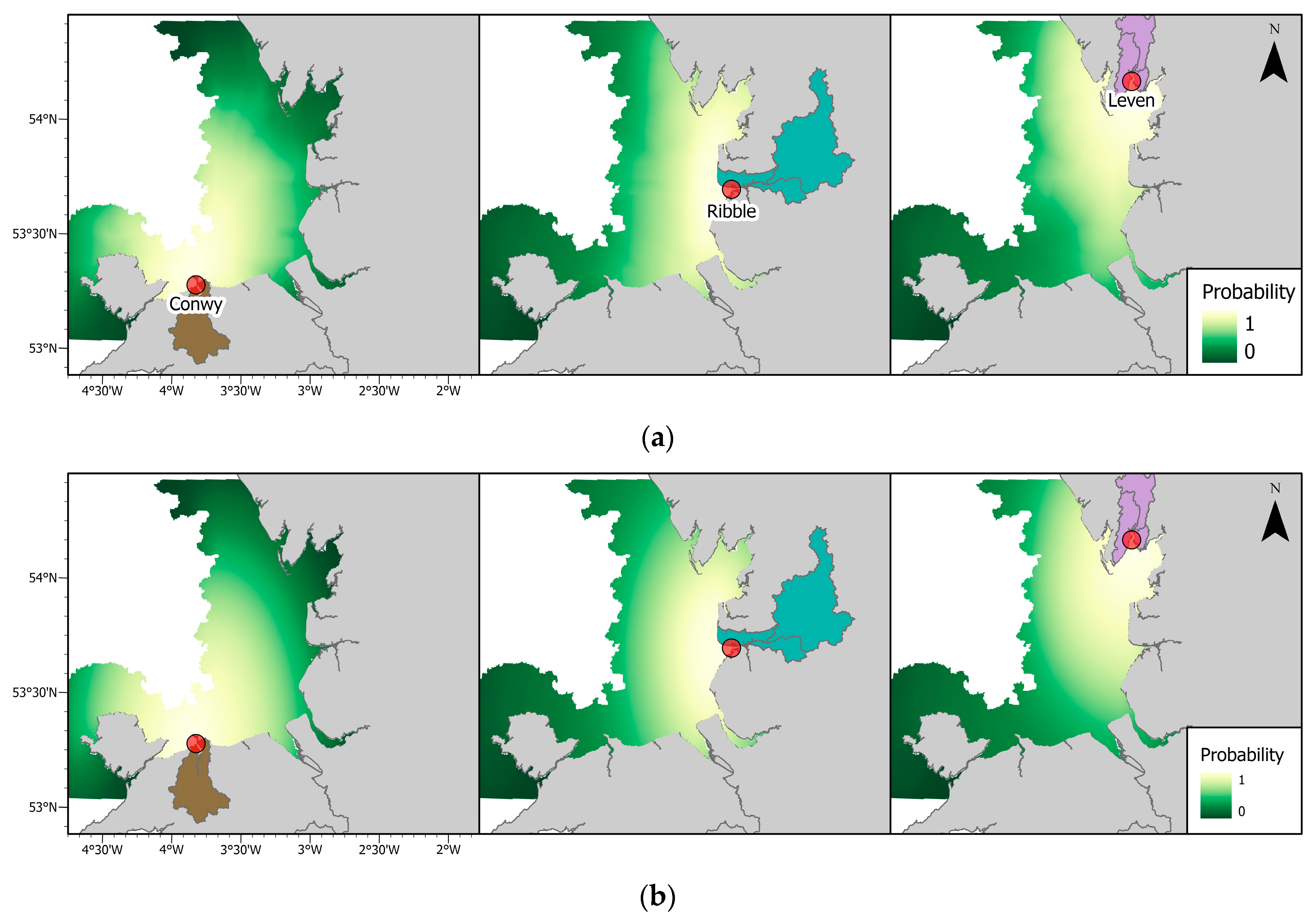
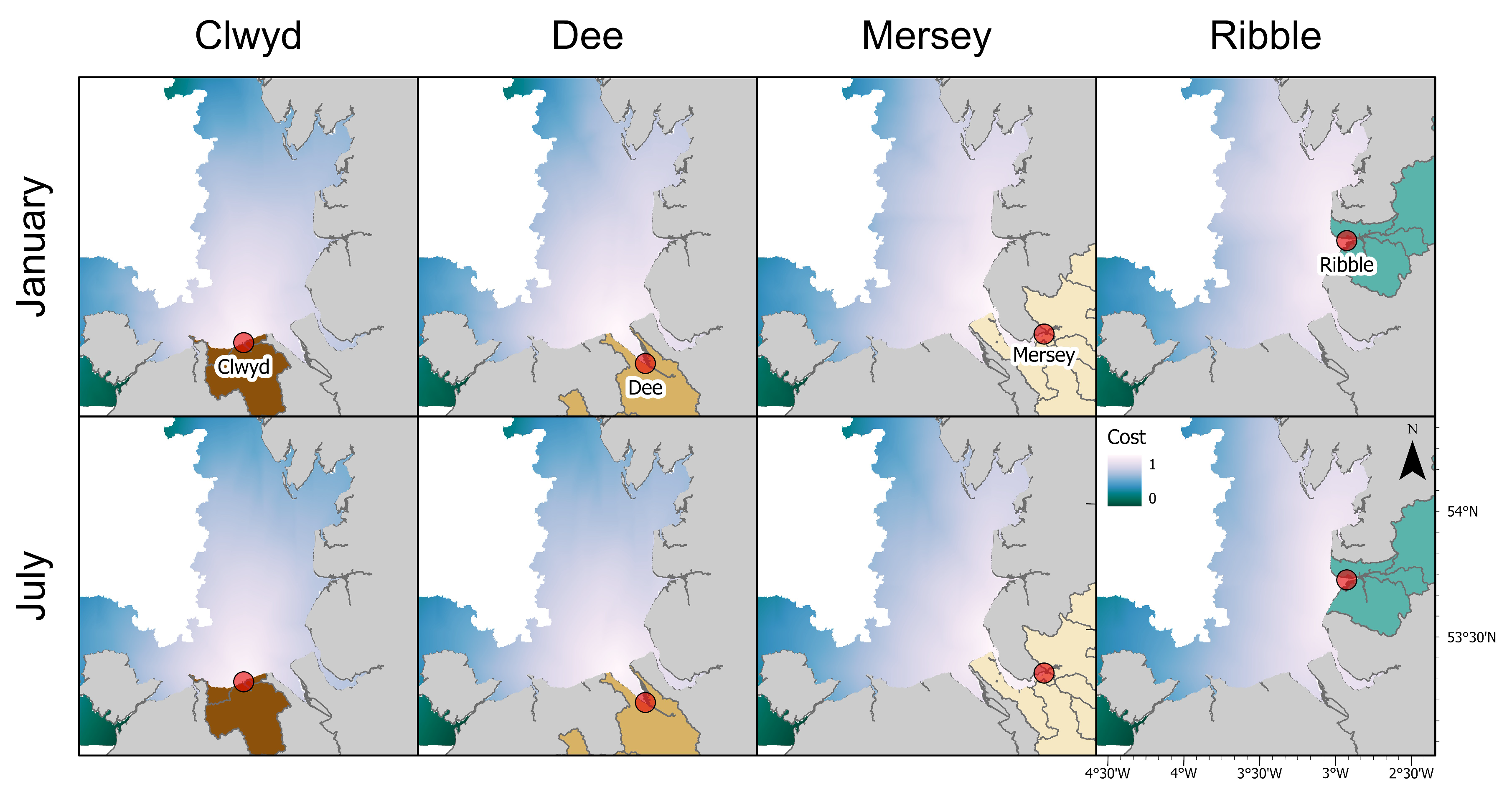
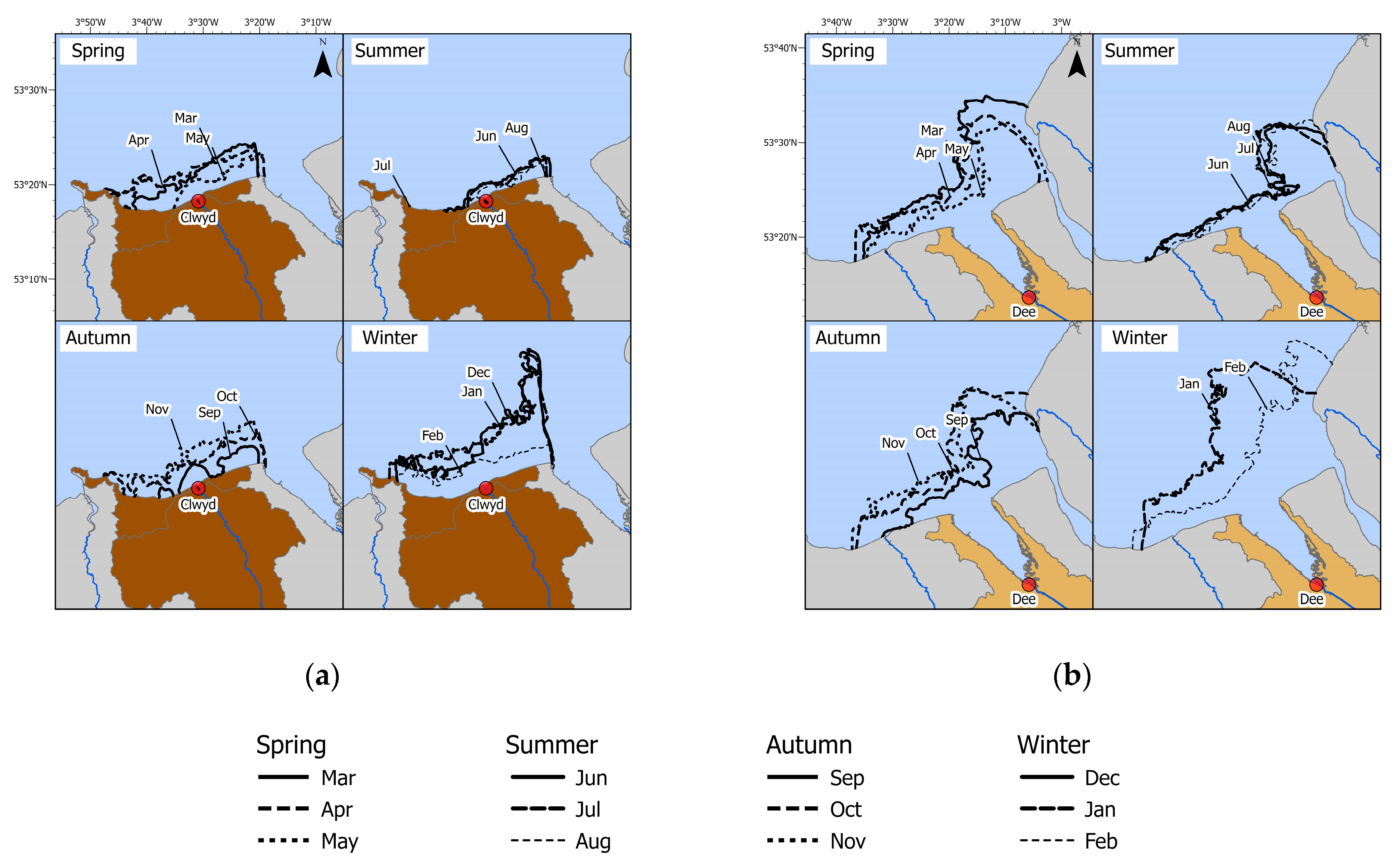
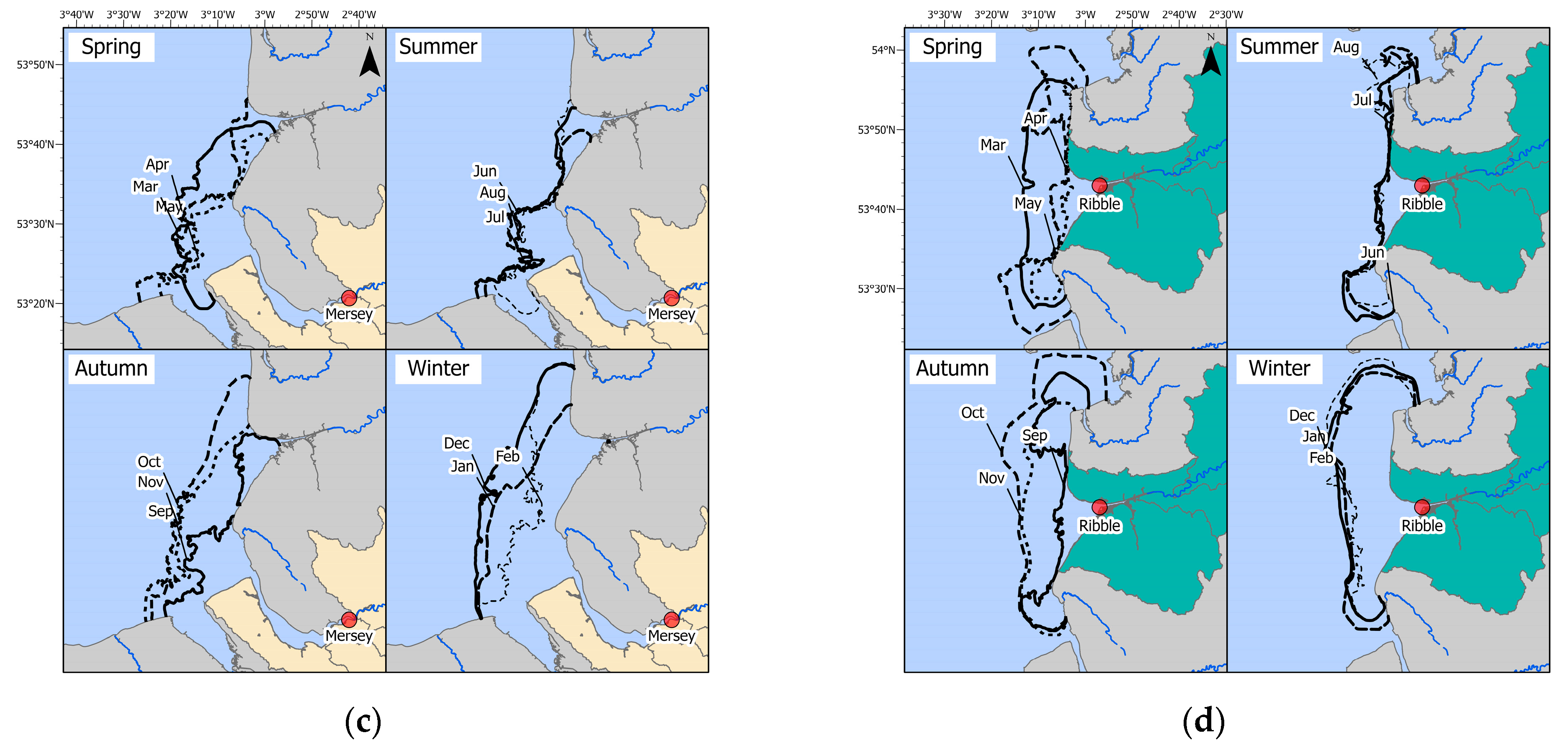
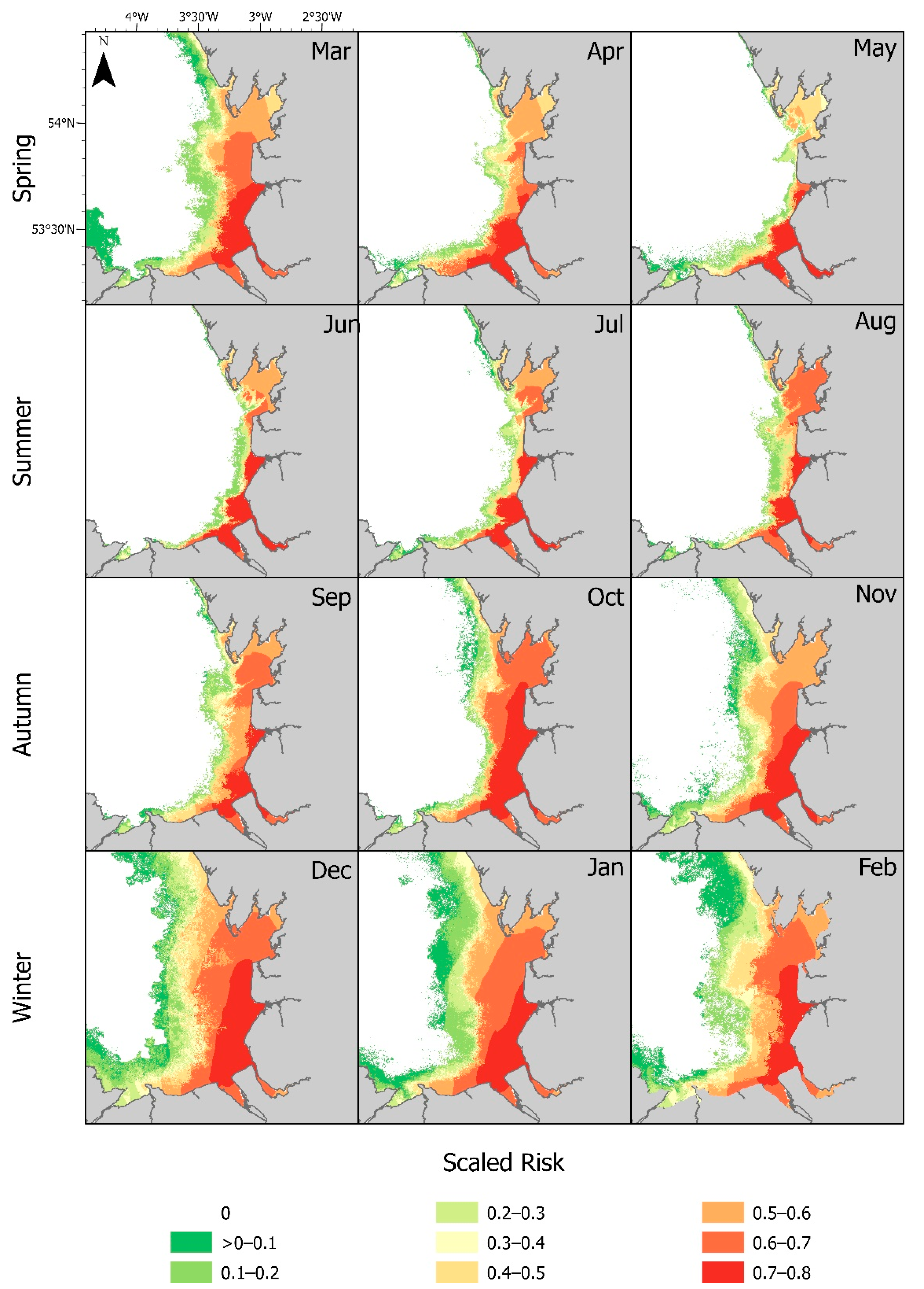
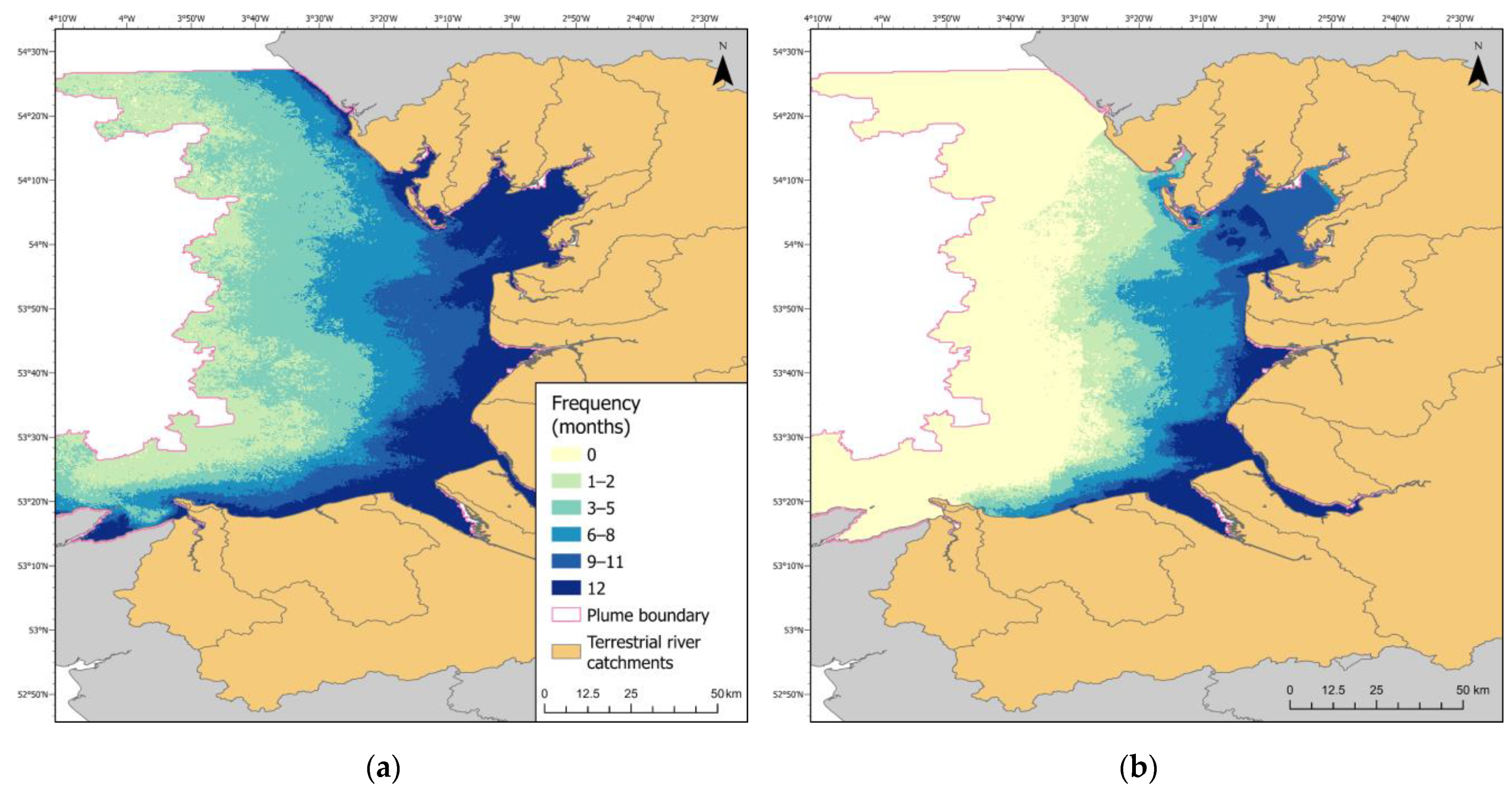
| River | Jan. | Feb. | Mar. | Apr. | May | Jun. | Jul. | Aug. | Sep. | Oct. | Nov. | Dec. |
|---|---|---|---|---|---|---|---|---|---|---|---|---|
| Clwyd | 2392 | 2216 | 1388 | 892 | 482 | 513 | 349 | 331 | 529 | 914 | 1401 | 2573 |
| Dee | 4457 | 3208 | 1959 | 1749 | 1393 | 1243 | 787 | 875 | 1174 | 1425 | 2047 | 3994 |
| Mersey | 6597 | 5844 | 6763 | 4342 | 5121 | 4927 | 4404 | 5003 | 4150 | 4379 | 5561 | 6772 |
| Ribble | 3328 | 2994 | 1811 | 838 | 533 | 2160 | 1598 | 1698 | 1404 | 1910 | 1998 | 4914 |
| Lune | 923 | 806 | 199 | 113 | 35 | 114 | 57 | 863 | 270 | 268 | 511 | 894 |
| Bela | 2116 | 2082 | 1903 | 731 | 551 | 477 | 785 | 975 | 1208 | 1486 | 1702 | 2759 |
| Leven | 532 | 550 | 354 | 214 | 138 | 141 | 139 | 229 | 194 | 309 | 403 | 487 |
| Others * | 531 | 396 | 310 | 133 | 117 | 107 | 172 | 186 | 201 | 250 | 365 | 555 |
| Total | 20,876 | 18,096 | 14,687 | 9012 | 8370 | 9682 | 8291 | 10,160 | 9130 | 10,941 | 13,988 | 22,948 |
| Annual Frequency of DIN Exposure Risk (Months at Risk) | Area with DIN Exposure Risk Greater than 0 (km2) | Area with DIN Exposure Risk Greater than 0.5 (km2) |
|---|---|---|
| 0 | 26.8 (0.3) | 5148.6 (60.8) |
| 1–2 | 2832.4 (33.4) | 984.3 (11.6) |
| 3–5 | 2518.6 (29.7) | 643.3 (7.6) |
| 6–8 | 1072.0 (12.7) | 750.6 (8.9) |
| 9–11 | 511.5 (6.0) | 365.9 (4.3) |
| 12 | 1511.7 (17.8) | 580.4 (6.8) |
Disclaimer/Publisher’s Note: The statements, opinions and data contained in all publications are solely those of the individual author(s) and contributor(s) and not of MDPI and/or the editor(s). MDPI and/or the editor(s) disclaim responsibility for any injury to people or property resulting from any ideas, methods, instructions or products referred to in the content. |
© 2023 by the authors. Licensee MDPI, Basel, Switzerland. This article is an open access article distributed under the terms and conditions of the Creative Commons Attribution (CC BY) license (https://creativecommons.org/licenses/by/4.0/).
Share and Cite
Heal, R.; Fronkova, L.; Silva, T.; Collingridge, K.; Harrod, R.; Greenwood, N.; Devlin, M.J. A Probabilistic Approach to Mapping the Contribution of Individual Riverine Discharges into Liverpool Bay Using Distance Accumulation Cost Methods on Satellite Derived Ocean-Colour Data. Remote Sens. 2023, 15, 3666. https://doi.org/10.3390/rs15143666
Heal R, Fronkova L, Silva T, Collingridge K, Harrod R, Greenwood N, Devlin MJ. A Probabilistic Approach to Mapping the Contribution of Individual Riverine Discharges into Liverpool Bay Using Distance Accumulation Cost Methods on Satellite Derived Ocean-Colour Data. Remote Sensing. 2023; 15(14):3666. https://doi.org/10.3390/rs15143666
Chicago/Turabian StyleHeal, Richard, Lenka Fronkova, Tiago Silva, Kate Collingridge, Richard Harrod, Naomi Greenwood, and Michelle J. Devlin. 2023. "A Probabilistic Approach to Mapping the Contribution of Individual Riverine Discharges into Liverpool Bay Using Distance Accumulation Cost Methods on Satellite Derived Ocean-Colour Data" Remote Sensing 15, no. 14: 3666. https://doi.org/10.3390/rs15143666
APA StyleHeal, R., Fronkova, L., Silva, T., Collingridge, K., Harrod, R., Greenwood, N., & Devlin, M. J. (2023). A Probabilistic Approach to Mapping the Contribution of Individual Riverine Discharges into Liverpool Bay Using Distance Accumulation Cost Methods on Satellite Derived Ocean-Colour Data. Remote Sensing, 15(14), 3666. https://doi.org/10.3390/rs15143666










